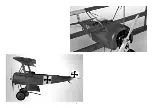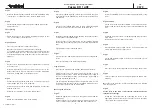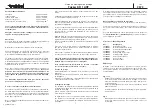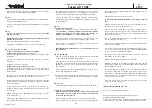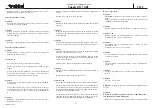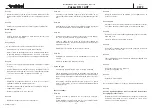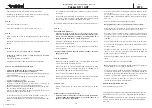
Fokker DR 1 ARF
6
2572
No.
Assembly and operating instructions
© robbe Modellsport
Errors and omissions excepted. Modifications reserved.
Copyright robbe-Modellsport 2012
Copying and re-printing, in whole or in part, only with prior written
approval of robbe-Modellsport GmbH & Co. KG
- Fix the receiver in the fuselage using Velcro tape.
- Deploy the receiver aerial(s) as recommended in the RC system
instructions.
Fig. 55
- Connect the speed controller to the receiver.
- Connect the speed controller to the motor, and secure it using
Velcro tape.
Fig. 56
- Stick a strip of Velcro tape to the servo plate to secure the flight
battery.
- Apply a mating strip of Velcro tape to the underside of the flight
battery.
Fig. 57
- Place the battery in the model but
do not connect it at this stage.
- Switch the transmitter on, and move the throttle stick to the
“motor off” end-point.
- Give the flight pack a full charge, install it in the fuselage, and
connect it to the speed controller.
- Program the speed controller as described in the instructions sup-
plied with it.
Figs. 58 - 60, checking the working systems
- Check the channel assignment at the receiver.
- Check the neutral position
of the control surfaces.
- Adjust the rudder and elevator linkages if necessary.
- Carry out fine corrections to the ailerons at the transmitter.
- Stand behind the model.
- Check the direction of rotation of the servos.
- When you move the aileron stick to the right, the right-hand aileron
should rise, the left-hand aileron fall.
- Pull the elevator stick back towards you, and the rear edge of the
elevators should rise.
- When you move the rudder stick to the right, the rudder should
deflect to the right.
- If any of the control surface functions works the wrong way round,
correct it using your transmitter’s servo reverse facility for that
function.
- Set the control surface travels to the stated values.
- The travels are measured at the inboard end of the control sur-
faces.
- The stated control throws are just a guide for the first few flights.
The exact settings will need to be adjusted to suit the individual
pilot‘s flying style.
- The Expo settings should also be adjusted to suit the pilot‘s prefe-
rence.
Fig. 61
Checking the power system
- Hold the model in such a way that the propeller is free to rotate.
Caution: Whenever you are working on the power system (for
installation, set-up or maintenance), keep well clear of the
rotational plane of the propeller - injury hazard.
- Check the direction of rotation of the motor: the propeller must turn
anti-clockwise when viewed from the front.
- If this is not the case, swap over any two of the three wires bet-
ween the motor and the speed controller.
- First disconnect the flight battery from the speed controller,
then switch the transmitter off.
Fig. 62, balancing
- Mark the Centre of Gravity - „C.G.“ - on both sides of the fuselage
at a point 87 mm from the leading edge of the top wing.
- Support the model at the marked points and allow it to hang freely.
Ideally the model will now balance level, with the nose inclined
slightly down.
- Adjust the position of the flight battery if necessary.
- Mark the battery location in the fuselage, so that you can be confi-
dent of replacing it in the same position after removing it.
Figs. 63 and 64
- Glue the tip skids to the bottom wings as shown.
Test-flying, flying notes
- Read the sections in the Safety Notes entitled “Routine pre-
flight checks” and “Flying the model” before attempting to fly
the model for the first time.
- For your first few flights please wait for a day with no more than a
gentle breeze.
- A good flying site consists of a large, flat, open grassy field, devoid
of trees, fences, high-tension overhead cables etc.
- Repeat the check of all the working systems.
- The model must always be taken off directly into any wind.
- Carry out a series of taxi tests to become accustomed to the
model‘s ground handling and response to the control surfaces.
- With the nose pointing straight into wind, apply full-throttle and
allow the Fokker to pick up speed. When flying speed is reached,
lift off with a brief application of up-elevator.
- Keep the Fokker flying straight and level at first; don’t initiate a turn
while it is still close to the ground.
- Adjust the control surface trims if necessary, so that the model flies
straight with a reasonable rate of climb “hands off”.
- Check the model‘s response to control commands. You may need
to increase or reduce the control surface travels after the first lan-
ding.
- Check the aeroplane’s stalling speed at a safe height.
- Keep the aeroplane’s speed well above the stall for the landing
approach.
Note:
biplanes and triplanes with a „tail-dragger“ undercarriage
invariably have a high Centre of Gravity which makes them tend to
nose-over when landing.
- If you needed to adjust the trims during the test-flight, correct the
length of the appropriate pushrod once the model is back on the
ground, then return the transmitter trims to centre so that full trim
travel is available to both sides of neutral for subsequent flights.
- Check that all the screws and nuts which secure the wing struts are
still tight.
robbe Modellsport GmbH & Co. KG
We reserve the right to introduce technical modifications.
Summary of Contents for 2572
Page 2: ...2 ...
Page 23: ...23 robbe Modellsport ...


